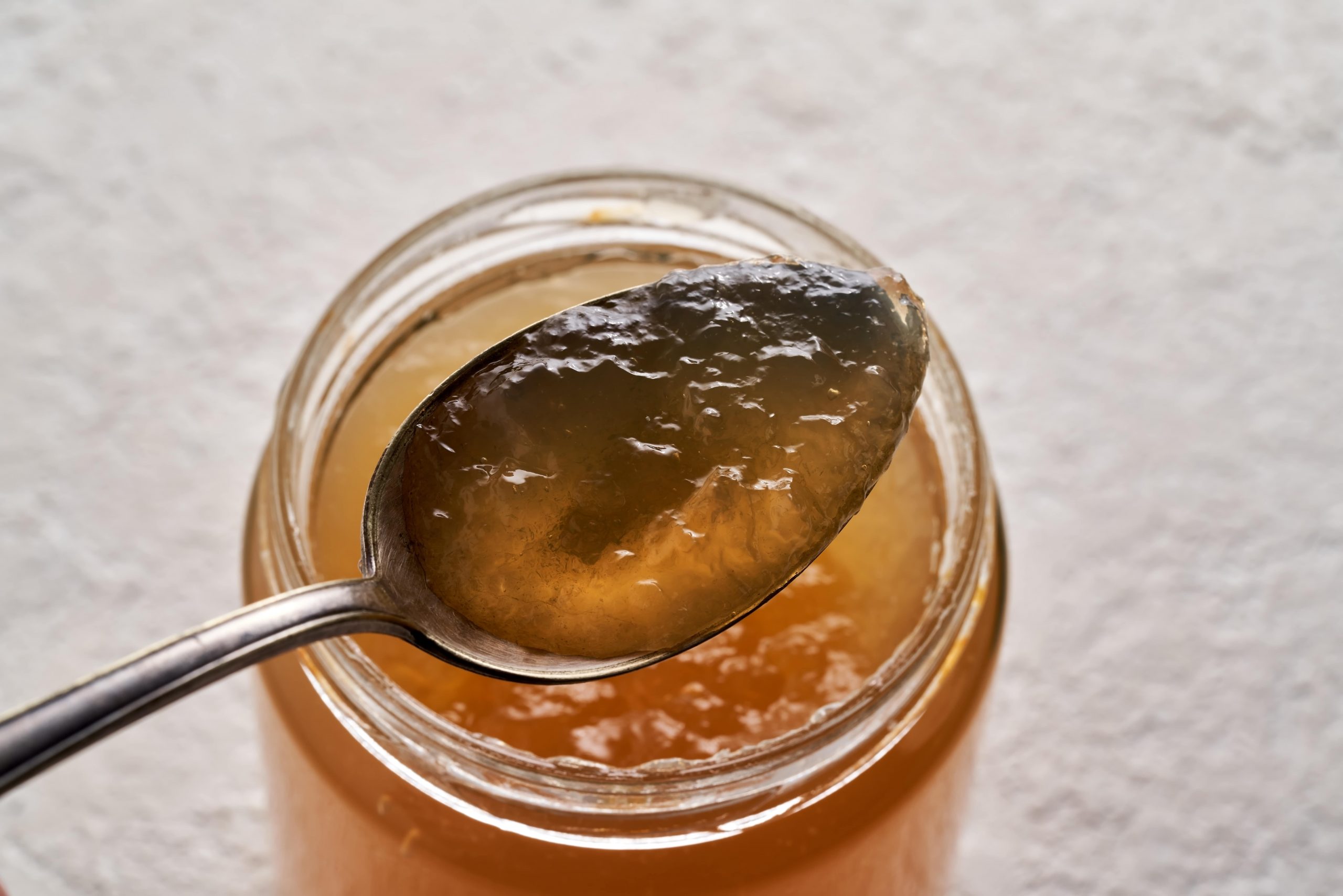Even if you don’t know what gelatin is, you’ve probably eaten it without even realizing it. It’s often sitting in the background of many delicious foods.
Of course, you can’t really taste gelatin, so you might not know it’s there, but it’s probably creating just the right texture for that dish you’re eating. And it’s definitely improving the meal’s nutritional value.
If you’ve ever had Jell-O, gelatin is what gives it that wonderfully jiggly texture. However, bone broth is where gelatin truly shines. Not only does the gelatin help thicken the broth, but it’s what makes it so hearty. It’s filling and chock-full of nutrients that are great for your body. And hey — it doesn’t hurt that a cup of bone broth is downright delicious.

What Is Gelatin?
Gelatin is a type of protein that comes from animals. But, it doesn’t come from the meat of the animal as you might expect. Instead, gelatin comes from the parts of the animal that you’re less likely to eat at your table. Namely, the gelatinous bits that you’d find around the bones, the skin, connective tissue, and the like.
Now, that may sound a bit unpleasant, but it really isn’t! In fact, gelatin itself is mostly colorless and flavorless. So you really wouldn’t taste it in whatever you’re eating. When it comes to cooking, gelatin works as a natural thickener. It works so well because of how little an effect it has on food aside from improving the texture.
Of course, there is one other way that gelatin affects food. It adds plenty of nutritional value and potential health benefits. Adding some gelatin to your diet can lead to improved digestion and better joint, bone, and skin health. It could even improve your sleep! You’re probably wondering how, so we’ll get right to that.
What Is Gelatin Made Of?
As we just mentioned, gelatin comes from animal parts, but that’s not as important as what makes up gelatin. On its own, gelatin is almost entirely protein. However, it also includes a long list of amino acids that are fantastic for your body. Most importantly, though, is that gelatin contains a relatively high amount of glycine and proline. These amino acids are non-essential because your body can make them on its own, but consuming more of these amino acids is beneficial.
Glycine and proline are crucial because they’re building blocks for collagen. Collagen is another protein found throughout our bodies, supporting our bone and joint strength and keeping our digestive system healthy. Glycine is also important for removing toxic substances from our bodies, while proline aids in a whole host of chores, including the formation of new cells.
In short, gelatin is a beneficial substance because of its high protein content and its unique composition of amino acids.
How Is Gelatin Made?
Factories process gelatin from animal remains. Gelatin can take the form of either granules, sheets, or dissolvable blocks through the manufacturing process. Those are what you’d buy from stores, and you can easily add them to whatever you’re cooking.
If you don’t want to buy processed gelatin, the best way to get it at home is by buying or making bone broth. The process of simmering bones in water for hours easily breaks down that gelatin along with the delicious flavors of the meat. Then, add in some veggies, spices, and herbs, and you’re in for a real treat.
How Much Bone Broth Should You Have?
Adults should consume 46 – 56g of protein daily. Because of the gelatin in the bone broth, it’s a fantastic source of your daily protein. Of course, gelatin doesn’t have all the nutrients different proteins have to offer. It would be best if you consumed a variety of different proteins from other sources, such as meat or legumes. A warming cup of bone broth a few times a week would be a fantastic way to improve your diet.
If you don’t want to go through all the effort of making your own broth, there are many fantastic sources of bone broth on the market, including our own. We also have a few of our favorite recipes to share with you so you can enjoy your broth in a variety of ways.
What Else Is Gelatin In?
Although we think it’s the best way to get some gelatin, bone broth isn’t the only food you’ll find it in. Gelatin is used in plenty of foods and dishes to give them the right texture. In case you didn’t know, here are some fairly common foods you’re likely to find gelatin in:
- Marshmallows
- Candies (such as gummies)
- Yogurts
- Icings
- Cough drops
If you’re curious whether or not something contains gelatin, all you need to do is check the label, as it should appear listed in the food’s ingredient list.
Of course, you can also just buy gelatin at the store to use in whatever you want. That way, you can add the benefits of gelatin to your food even if you don’t have bone broth. For example, many soup stocks from stores these days don’t have gelatin in them, so adding some that you bought or made is a quick way to improve any soup. Not that soup is your only option for adding gelatin. It’s common to add it to desserts to get that jelly texture, but you can also add gelatin to foods like smoothies for the resulting health benefits.
Conclusion: Is Gelatin Healthy?
On its own, yes. Gelatin itself is a fantastic source of protein. It’s also a great way to consume more glycine and proline, which are both beneficial and necessary for many reasons. Your body will thank you for eating more gelatin.
But, what foods you’re eating the gelatin in also matter. You can easily get gelatin from sugary snacks, but that’s not going to be very healthy for you. There’s just not enough gelatin in candy to counteract the negative effects of all that sugar.
Instead, we’d suggest getting your gelatin from a warm, delicious mug of bone broth. There’s no better way to spend an evening than curled up under a warm blanket sipping from that comforting cup of broth while reading a good book or watching your favorite show.
This content is for informational and educational purposes only. It is not intended to provide medical advice or to take the place of such advice or treatment from a personal physician. All readers/viewers of this content are advised to consult their doctors or qualified health professionals regarding specific health questions. Neither Babs Bone Broth nor the publisher of this content takes responsibility for possible health consequences of any person or persons reading or following the information in this educational content. All viewers of this content, especially those taking prescription or over-the-counter medications, should consult their physicians before beginning any nutrition, supplement or lifestyle program.




